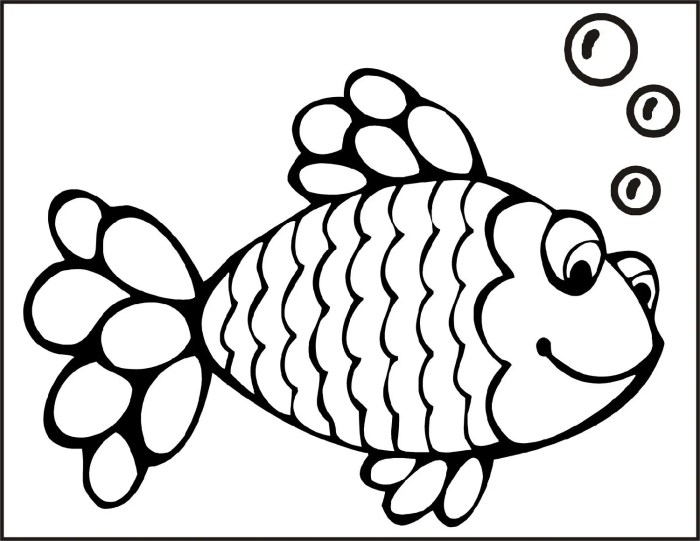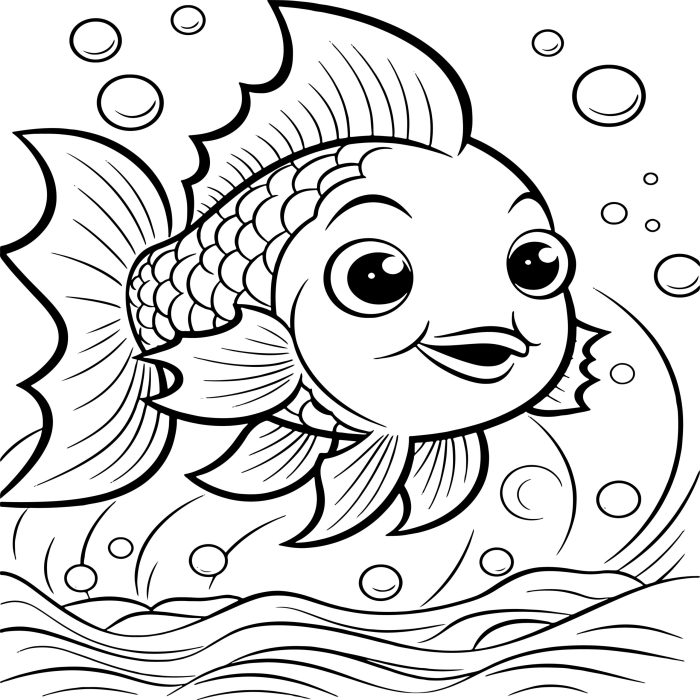Popularity and Trends

Coloring book pages of fish – Fish-themed coloring pages enjoy consistent popularity within the broader coloring book market, appealing to a diverse range of ages and interests. This enduring appeal stems from the inherent visual appeal of fish, their diverse forms, and the opportunity for creative expression they offer. The market, however, is dynamic, reflecting evolving artistic styles and consumer preferences.The current popularity of fish-themed coloring pages is substantial, driven by the ongoing trend of adult coloring books and the continued appeal of aquatic life to children.
While precise sales figures for this niche market are difficult to obtain, the overall growth of the coloring book industry provides a strong indication of its health. Major online retailers and bookstores consistently stock a variety of fish-themed coloring books, demonstrating ongoing market demand.
Current Trends in Fish Illustrations, Coloring book pages of fish
Current trends in fish illustrations for coloring books show a diversification of styles. Realistic depictions, showcasing intricate details of scales, fins, and coloration, remain popular, particularly among adult colorists who appreciate the challenge and detail. Conversely, cartoonish and whimsical illustrations, often featuring simplified shapes and exaggerated features, cater to younger audiences and those seeking a less demanding coloring experience.
Specific fish species, such as koi, betta fish, and clownfish, enjoy heightened popularity due to their vibrant colors and recognizable features, frequently appearing in dedicated coloring books or as part of larger aquatic-themed collections. The trend also reflects a growing interest in marine conservation, with some coloring books featuring endangered or less commonly known species, promoting awareness and appreciation for marine biodiversity.
Comparison to Other Animal-Themed Coloring Pages
Fish coloring pages hold a significant, albeit not dominant, position within the broader animal-themed coloring book market. While mammals (cats, dogs, etc.) and birds consistently occupy a larger market share due to their broader cultural appeal and familiarity, fish-themed pages maintain a steady presence, particularly within niche markets focusing on marine life or specific aquatic habitats. The competitive landscape also includes other animal groups, such as insects, reptiles, and amphibians, each with its dedicated following.
The relative popularity of fish coloring pages often depends on current trends and seasonal factors, such as the release of popular animated films featuring aquatic characters.
Estimated Market Size for Fish-Themed Coloring Books
The following table provides estimated market size data for fish-themed coloring books, segmented by age group. These figures are based on estimations derived from overall coloring book market analysis and reports from major publishers and retailers, acknowledging inherent limitations in precisely quantifying this niche market. These estimates are for illustrative purposes and should not be taken as precise financial data.
Growth rates reflect anticipated market expansion, considering factors like the ongoing popularity of adult coloring and the potential for increased awareness of marine conservation.
| Age Group | Estimated Market Size (USD Million) | Growth Rate (Year-over-Year) | Key Trends |
|---|---|---|---|
| Children (0-12) | 5-10 | 3-5% | Cartoonish illustrations, simple designs, popular characters |
| Teens (13-19) | 2-5 | 2-4% | Stylized designs, trending aesthetics, incorporation of pop culture elements |
| Adults (20+) | 3-7 | 4-6% | Intricate designs, realistic illustrations, therapeutic focus |
| All Ages | 10-22 | 3-5% | Diverse styles, themes incorporating marine conservation, educational elements |
Design Elements

Creating compelling fish coloring pages requires a thoughtful approach to design elements. The right combination of detail, color, and artistic style can captivate a wide range of ages and skill levels, leading to a more engaging and enjoyable coloring experience. This section delves into the key design considerations for crafting successful fish coloring pages.
Okay, so you’re into those chill fish coloring book pages, right? Totally get it, super relaxing. But if you’re feeling something a bit more pow, check out these awesome super hero coloring book pages – they’re fire! Then, after unleashing your inner artist with capes and masks, you can totally chill back out with those peaceful underwater scenes again.
It’s the perfect balance, you know?
Effective fish coloring page designs often incorporate a blend of intricate details and simpler shapes. Intricate designs appeal to older children and adults who enjoy the challenge of detailed coloring, while simpler designs are perfect for younger children who are still developing their fine motor skills. Background elements, such as coral reefs, seaweed, or ocean floors, can add context and visual interest, enhancing the overall aesthetic appeal.
The careful balance of these elements is crucial for creating pages that are both visually stimulating and appropriately challenging.
Color Palettes in Fish Coloring Pages
Color palettes play a significant role in the overall mood and appeal of a fish coloring page. Bright, vibrant colors are often used to depict tropical fish, creating a cheerful and energetic feel. Conversely, cooler, more muted tones might be chosen for fish inhabiting deeper, darker waters, conveying a sense of mystery and depth. The strategic use of color can significantly impact the final product, influencing the user’s creative process and the overall aesthetic.
For example, a page featuring a vibrant clownfish might use a palette of oranges, reds, and whites, while a page featuring a deep-sea anglerfish might utilize darker blues, purples, and blacks. Consideration should be given to the specific fish species and its natural habitat when selecting a color palette.
Artistic Styles in Fish Coloring Page Designs
Several artistic styles can be effectively employed in fish coloring page designs, each offering a unique visual experience. Realism aims for accurate representation, focusing on detailed anatomy and accurate coloration, often appealing to older children and adults who appreciate anatomical accuracy. Cartoon styles, characterized by simplified shapes and exaggerated features, are generally more suitable for younger children due to their playful and less demanding nature.
Manga-style designs, with their distinctive linework and expressive features, can create unique and visually appealing coloring pages, particularly for older children and teenagers familiar with the style. The choice of artistic style should align with the target audience and the overall design goals.
Examples of Coloring Page Layouts
Here are three different coloring page layouts, each designed with a specific audience and skill level in mind:
- Layout 1: Simple Tropical Fish (Ages 3-5, Beginner): This layout features large, simple shapes representing common tropical fish like angelfish and goldfish. The lines are thick and bold, making it easy for young children to color within the lines. The background is a simple, uncluttered design, focusing attention on the fish. The color palette is bright and cheerful, using primary colors and easy-to-blend shades.
A single, large fish is featured prominently on the page.
- Layout 2: Detailed Reef Scene (Ages 8-12, Intermediate): This layout depicts a more complex scene, including various fish species (a parrotfish, a pufferfish, and a seahorse) within a detailed coral reef setting. The lines are thinner and more intricate, requiring more precise coloring. The background features a variety of corals, seaweed, and other marine life, adding complexity and visual interest. The color palette is diverse, incorporating a wider range of shades and hues.
The layout encourages creativity and attention to detail.
- Layout 3: Realistic Shark (Ages 13+, Advanced): This layout features a realistic depiction of a great white shark, emphasizing detailed anatomy and accurate coloration. The lines are fine and intricate, requiring advanced coloring skills and patience. The background is a simple, dark blue ocean, allowing the shark to be the focal point. The color palette is more subdued, utilizing a range of grays, blues, and whites to create a realistic effect.
This layout challenges the user with fine details and shading techniques.
Fish Species Representation

Coloring books, particularly those targeted at children, often feature a select group of fish species. Understanding the reasons behind this selection, and exploring the potential for diversification, is key to creating engaging and visually appealing coloring pages. This analysis will delve into the common species depicted, the factors influencing their popularity, and suggest alternative choices to broaden the scope of fish representation.The most commonly depicted fish species in coloring books tend to be those that are visually striking, relatively simple in form, and culturally familiar.
Bright colors, easily recognizable shapes, and a lack of overly intricate details contribute to their appeal. This selection often prioritizes species that are already widely recognized through popular culture, children’s literature, or aquarium keeping. The simplicity of design also caters to the target audience, making them easy for children of various skill levels to color.
Commonly Depicted Fish Species
Goldfish, clownfish (Nemo), and betta fish consistently feature prominently in coloring books. Goldfish, with their simple, rounded bodies and vibrant colors, are classic choices. Clownfish, popularized by the movie “Finding Nemo,” benefit from pre-existing cultural recognition. Betta fish, known for their elaborate fins and intense colors, offer a more visually complex yet still manageable design for coloring. These species are readily available in illustrations and images which have been adapted for use in coloring book design.
Reasons for Popularity of Certain Species
The popularity of certain fish species in coloring book designs stems from a confluence of factors. Visual appeal, cultural familiarity, and ease of representation are key considerations. Bright colors, distinct shapes, and iconic status (like Nemo) make certain species instantly recognizable and engaging for children. The simplicity of their body structure simplifies the design process, resulting in coloring pages that are both aesthetically pleasing and easy to color.
Unique or Less Common Fish Species for Coloring Books
Expanding beyond the typical choices opens up opportunities for creative and educational coloring pages. Species like seahorses, with their unique body structure, or pufferfish, with their distinctive round shape and spiky texture, offer intriguing design challenges. Mandarinfish, known for their vibrant and intricate patterns, could also provide a more advanced coloring experience. Including less common species introduces children to the biodiversity of the underwater world, enriching their understanding of marine life.
A detailed depiction of a seahorse, for example, could involve a complex pattern of small details in its body and tail, offering a different kind of challenge compared to a simple goldfish.
List of Ten Fish Species Suitable for Coloring Pages
The following list categorizes ten fish species by difficulty level for coloring, considering factors such as body complexity, fin detail, and overall pattern intricacy.
- Beginner: Goldfish, Clownfish, Guppy
- Intermediate: Betta fish, Angelfish, Koi
- Advanced: Mandarinfish, Seahorse, Pufferfish, Lionfish
User Queries: Coloring Book Pages Of Fish
What are the best coloring pencils for fish coloring pages?
The best pencils depend on your preference. For vibrant colors, consider Prismacolor Premier or Faber-Castell Polychromos. For smoother blending, try Caran d’Ache Supracolor Soft. Experiment to find what works best for you.
Are there coloring pages for specific fish diseases?
No, coloring pages typically focus on healthy fish. Information on fish diseases is best obtained from veterinary sources or reputable aquatics websites.
Where can I find free printable fish coloring pages?
Many websites offer free printable fish coloring pages. A simple online search will yield numerous results.
How can I use fish coloring pages to teach children about conservation?
Discuss endangered species depicted in the coloring pages, emphasizing their importance and the threats they face. Encourage children to create their own conservation posters based on their colored pages.
